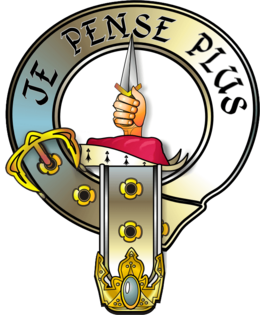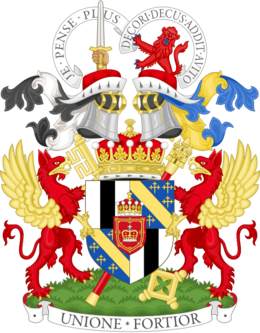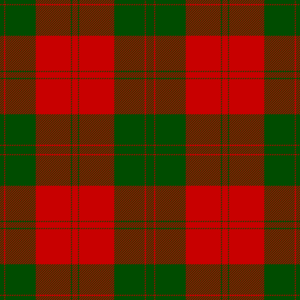Clan Erskine facts for kids
Quick facts for kids Clan Erskine |
|||
|---|---|---|---|
| Arascain ("air an sgian" - upon the knife) | |||

Crest: On a chapeau Gules furred Ermine a hand holding up a skene in pale Argent, hilted and pommelled or.
|
|||
| Motto | Je Pense Plus (I think more) | ||
| Profile | |||
| Region | Lowlands | ||
| Chief | |||
 |
|||
| James Thorne Erskine, | |||
| The 14th Earl of Mar and the 16th Earl of Kellie |
|||
| Historic seat | Alloa Tower | ||
|
|||
Clan Erskine is a Scottish clan from the Scottish Lowlands. A clan is like a large family group, often with a shared history and a chief.
Contents
History of Clan Erskine
Where the Erskine Name Comes From
The name Erskine comes from a place in Renfrew, Scotland. This area is south of the River Clyde. People think the name means "green rising ground" in an old language.
One of the first known Erskines was Henry de Erskine. He owned land in the area around 1226.
Supporting Robert the Bruce
During the Wars of Scottish Independence, the Erskines were important. A man named John de Irskyn was among the Scottish nobles who signed a document agreeing to King Edward I of England. This happened in 1296.
His son, Sir John de Irskyn, had three daughters. One of them married Thomas Bruce, who was the brother of the famous Scottish king, Robert the Bruce. This shows how the Erskines were connected to important Scottish families.
Important Roles in the 1300s
The Erskine family strongly supported the Clan Bruce. Sir Robert de Erskine was a very respected person at this time. King David II of Scotland made him the keeper of Stirling Castle. This was a very important castle.
In 1350, Sir Robert Erskine became the Chamberlain of Scotland. This meant he was in charge of the king's money and property in the north. He also helped decide who would be the next king. He supported Robert II of Scotland, who was Robert the Bruce's grandson. Robert II was the first king from the Stewart family.
Royal Guardians and a Famous Tower
In the 1400s, the chief of Clan Erskine wanted to claim the title of Earl of Mar. This was a very old and important Scottish title. However, the king said the title belonged to the crown.
Even with this disagreement, the Erskines became guardians for young kings. Five generations of Erskine chiefs looked after the royal children.
In 1497, Alexander Erskine, the third Lord Erskine, built Alloa Tower. This huge tower became the main home for the clan chiefs for the next 300 years. His son sadly died in 1513 at the Battle of Flodden.
John Erskine, the fifth Lord Erskine, was the guardian and teacher of King James V of Scotland.
Later, Mary, Queen of Scots, who had grown up near Alloa and Stirling Castle, gave the title of Earl of Mar to the sixth Lord Erskine. This was because his family had a connection to an earlier Earl of Mar.
Political Changes in the 1600s
The seventh Lord Erskine was involved in an event called the Raid of Ruthven in 1582. During this time, young King James VI of Scotland was held by a group of Protestant nobles. Erskine was sent away from Scotland for a while. But he later returned and became the Lord High Treasurer of Scotland in 1616.
Civil War and Royal Support
In 1615, Chief John Erskine, the 20th Earl of Mar, became the governor of Edinburgh Castle. He was a strong supporter of King Charles I. Lord Erskine fought for the king's side at the Battle of Kilsyth in 1645.
Because they supported the king, the family lost their lands for a short time. But King Charles II gave them back in 1660.
The Jacobite Risings
John Erskine, Earl of Mar, was sometimes called bobbing John. This was because he often changed his political side to help his family survive. He had supported the union of Scotland and England in 1707. But in 1714, he felt insulted when he wasn't given an important job in London.
So, he went back to Scotland and started a rebellion to support James VIII, also known as the Old Pretender. James VIII wanted to be king of Scotland and England. Erskine quickly gathered an army of over 10,000 clan members.
The Earl led his Jacobite army at the Battle of Sheriffmuir on November 13, 1715. They fought against the Duke of Argyll's forces. The battle didn't have a clear winner. After the rebellion failed, Erskine fled to France. His titles and lands were taken away.
Later, in 1824, the Erskine family got their earldom of Mar back. In 1835, the earldom of Kellie joined with the earldom of Mar.
Clan Chief
The current chief of Clan Erskine is James Erskine, 14th Earl of Mar. He is the head of the Erskine family and their coat of arms.
It's important to know that the Clan Mar has its own separate chief. This is Margaret of Mar, 31st Countess of Mar. She is the chief of the Mar family and their coat of arms.
Clan Tartan
| Tartan image | Notes |
|---|---|
| This is the Areskyn tartan. It was first shown in a book called Vestiarium Scoticum in 1842. |
Clan Castles
- Alloa Tower was the main home of the Clan Erskine chief for many years.
- The House of Dun was home to the Erskine family from 1375 until 1980. People have lived here for at least 9,000 years!
- Corgarff Castle was bought by John Erskine, 19th Earl of Mar in 1626.
- Kellie Castle was bought by Sir Thomas Erskine in 1613.
- Dryburgh Abbey was given to the Earl of Mar by King James VI of Scotland in 1544.
- Dirleton Castle
- Braemar Castle
- Rosslyn Castle
- Dunimarle Castle, near Culross, Fife, was built by the Erskine family in the 1700s.
- Kildrummy Castle was the home of the first Earls of Mar. It was left empty after the Jacobite Uprisings in 1716.
See also


